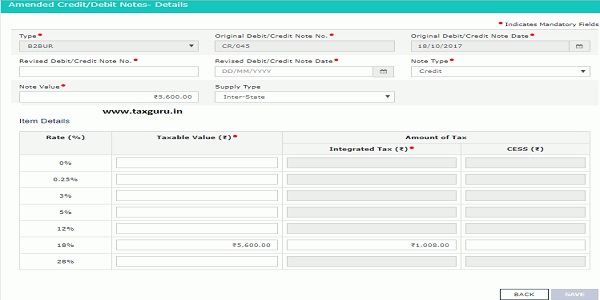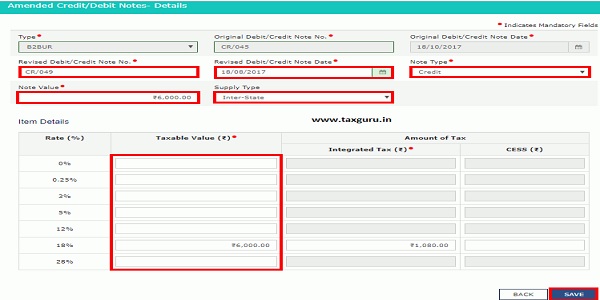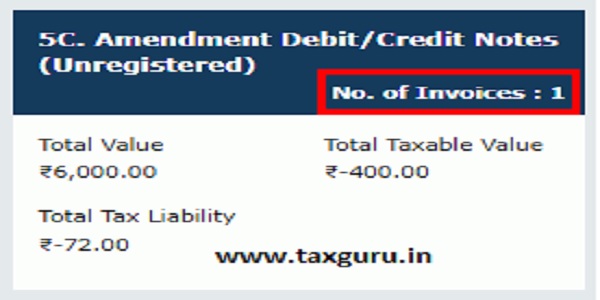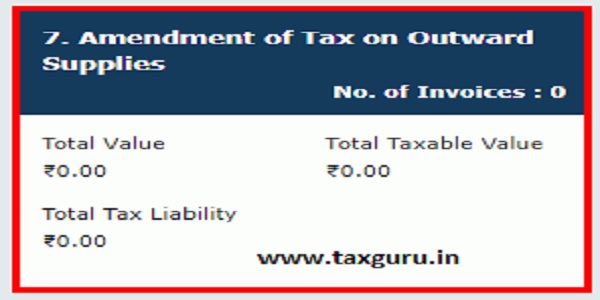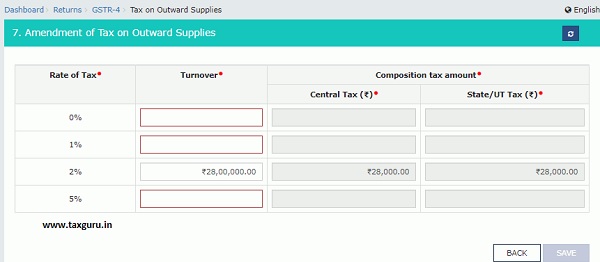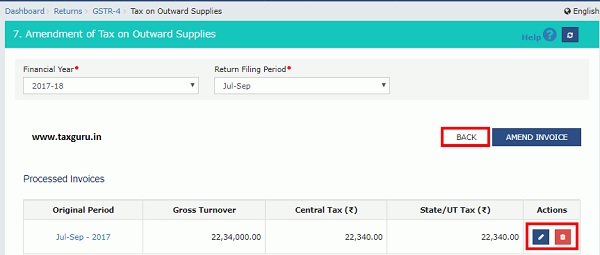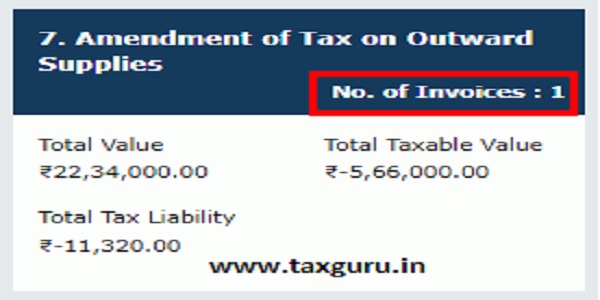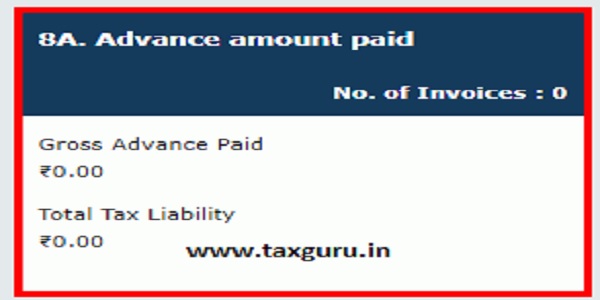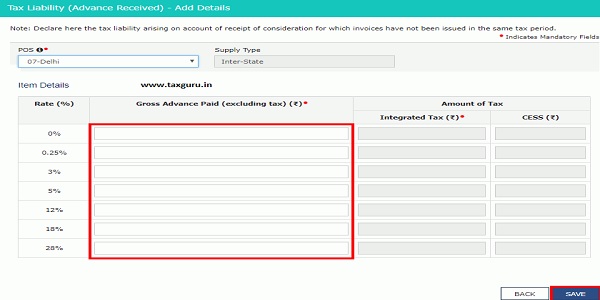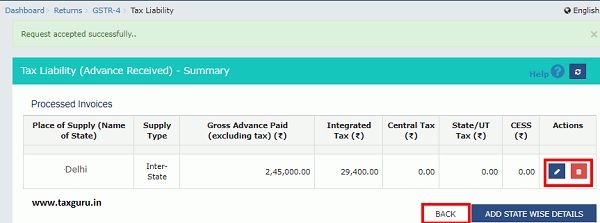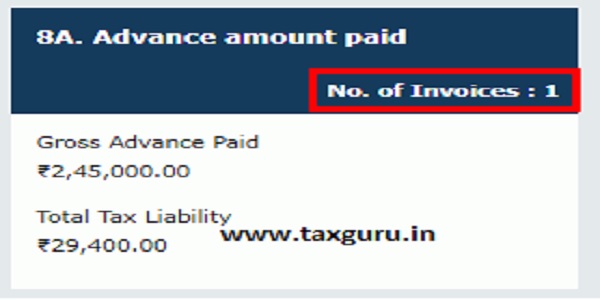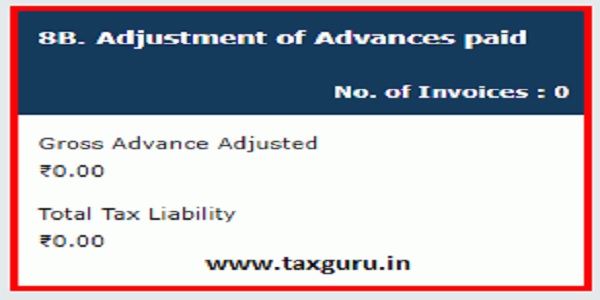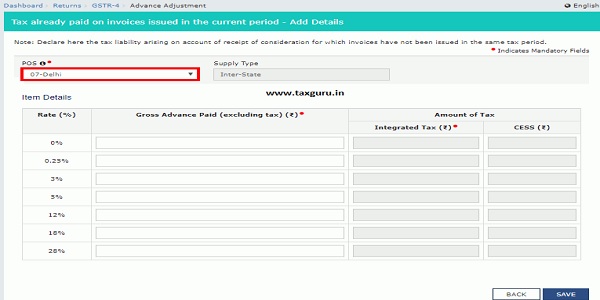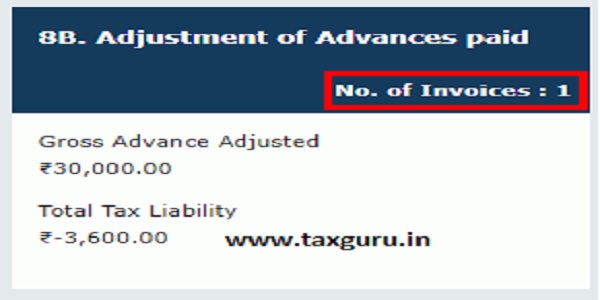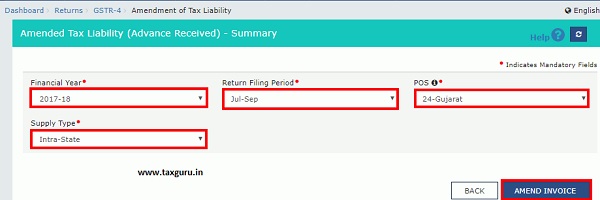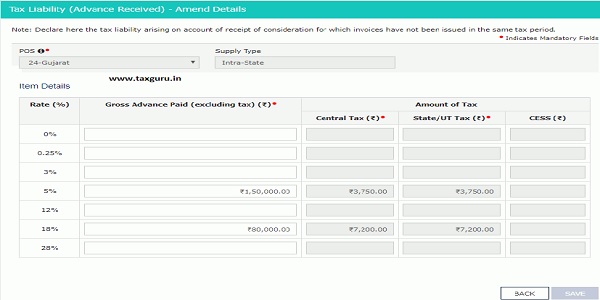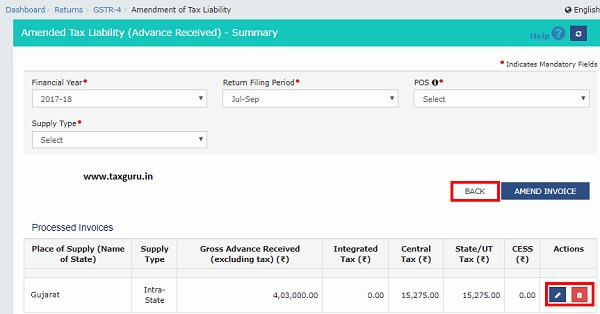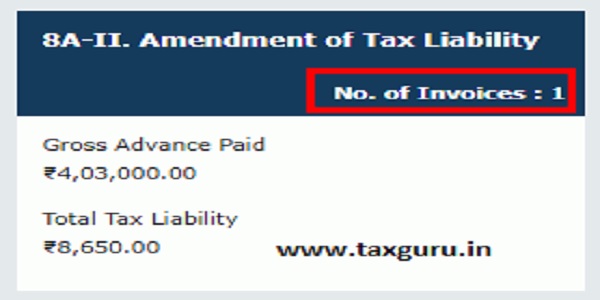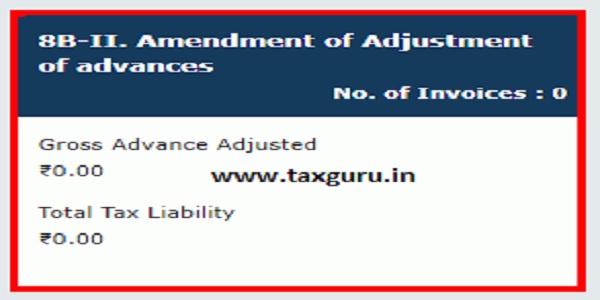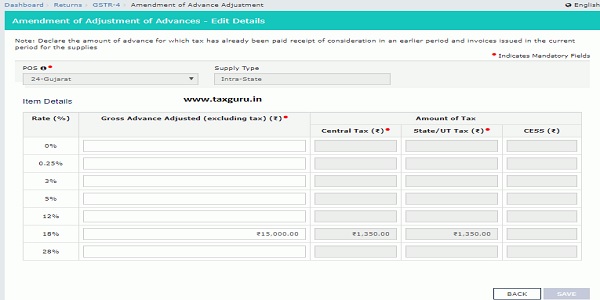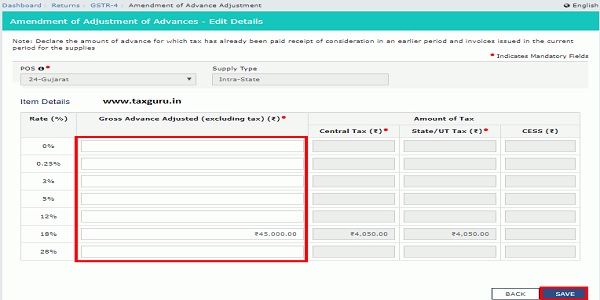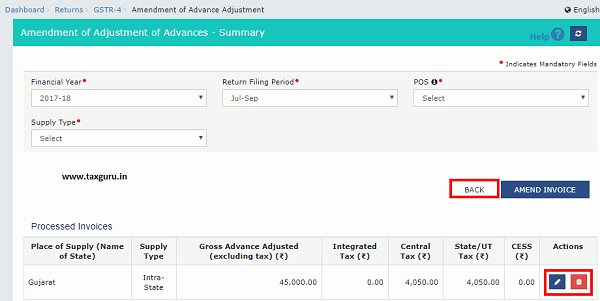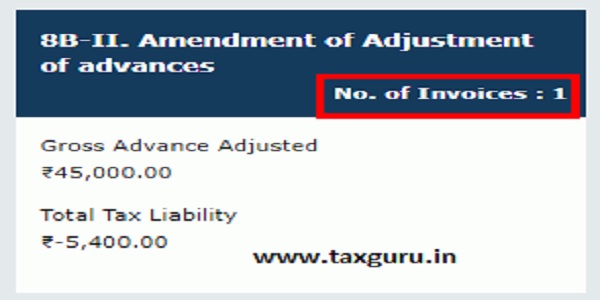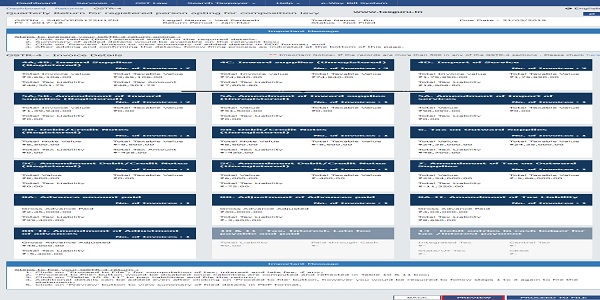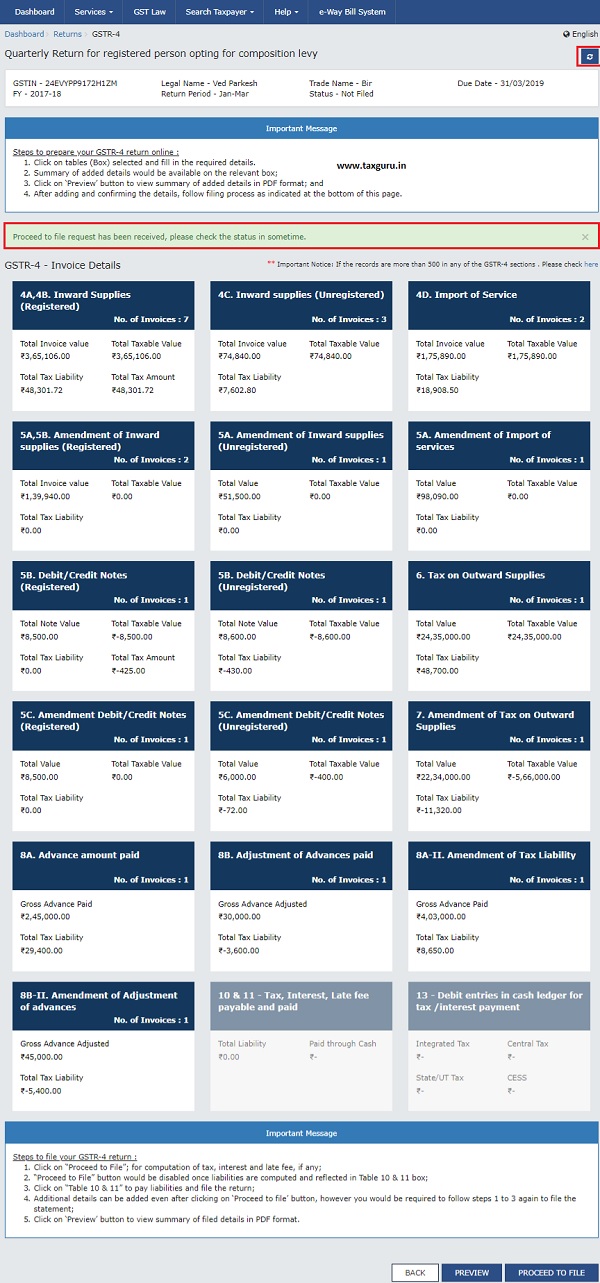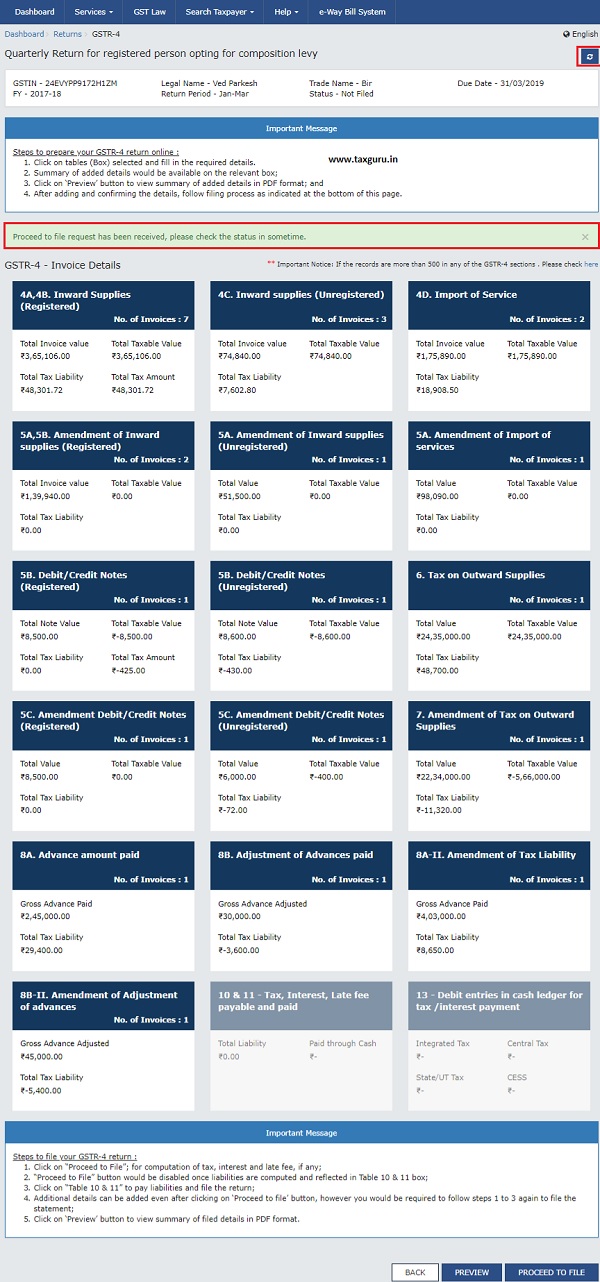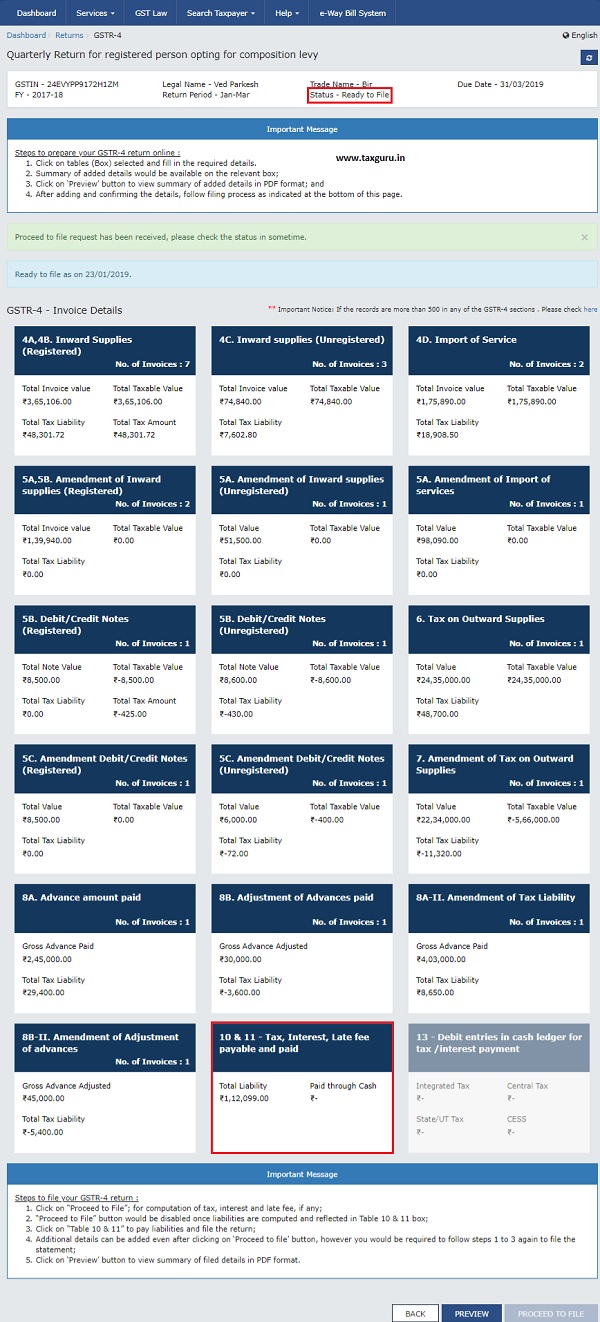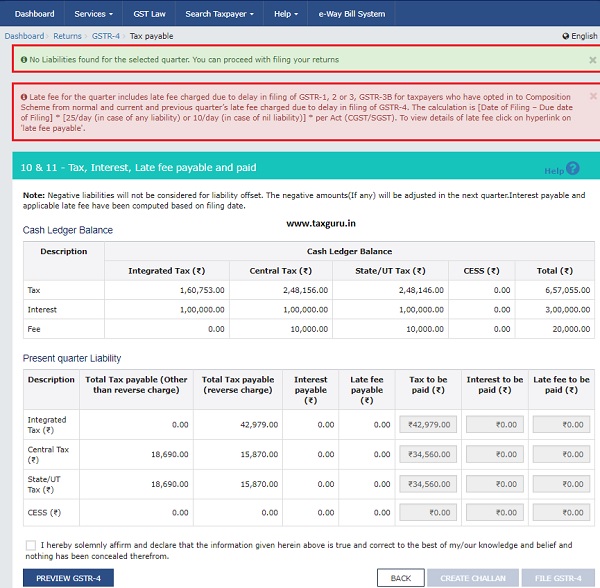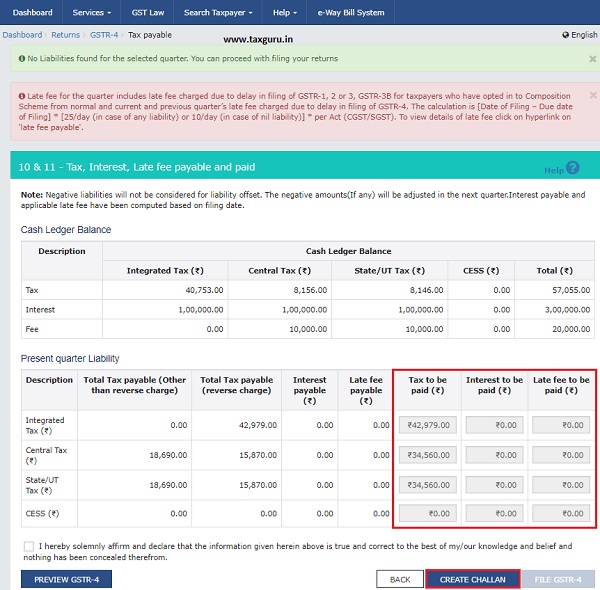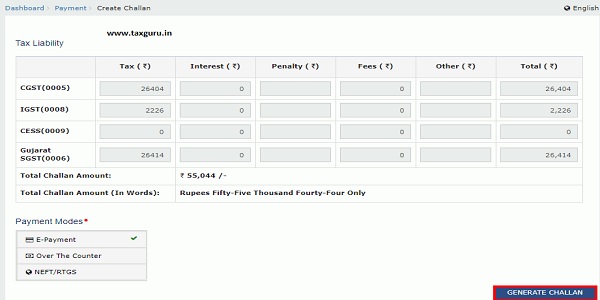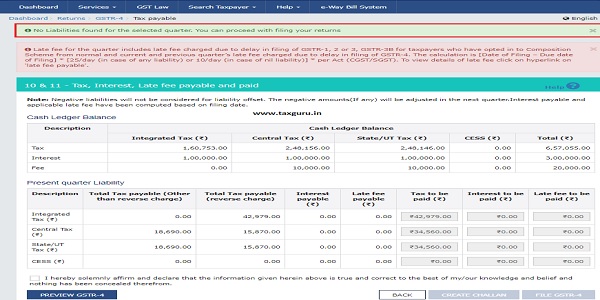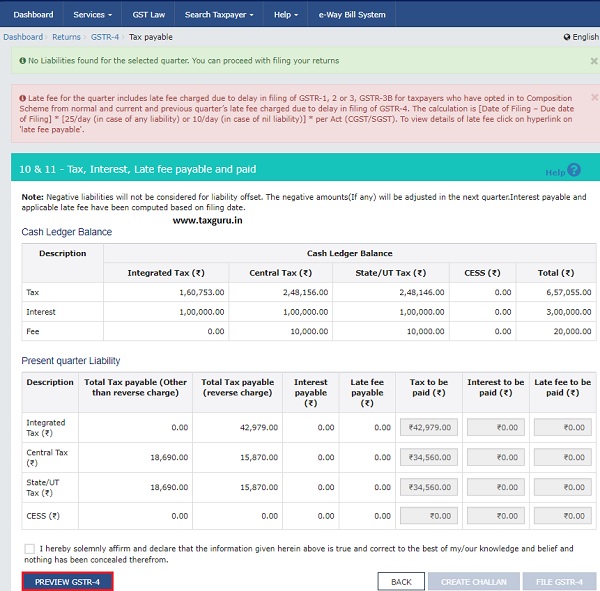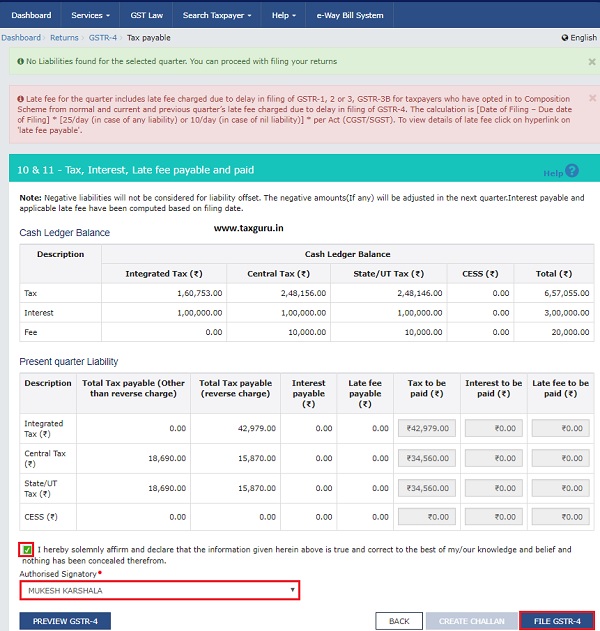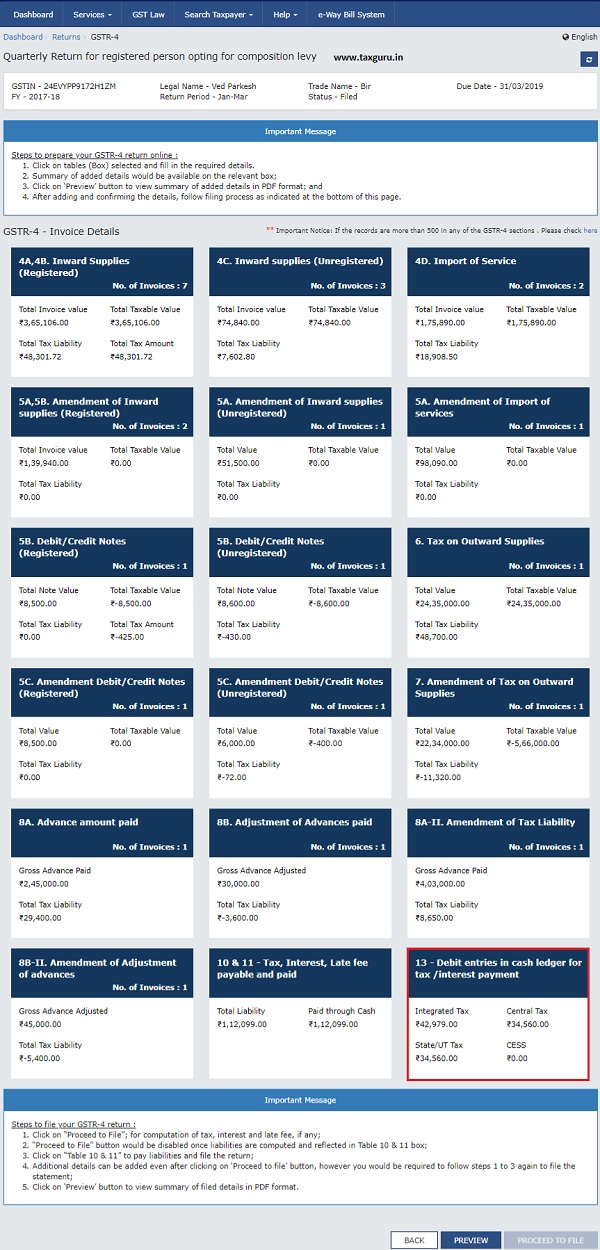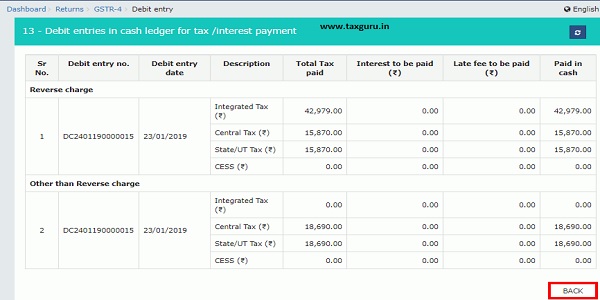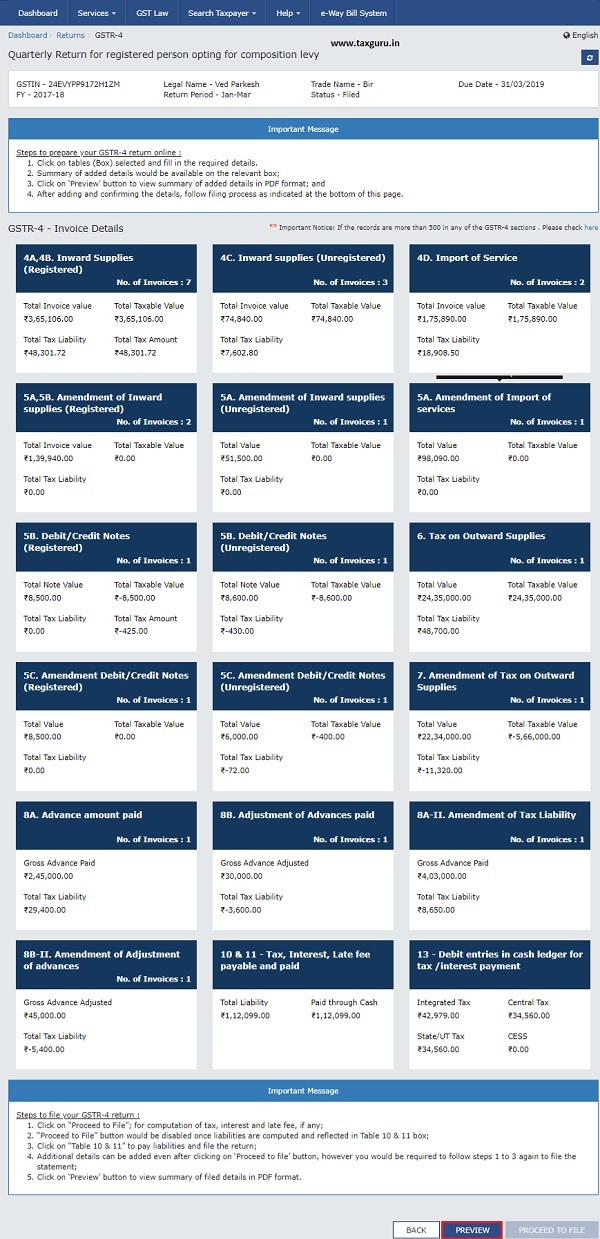How can I create and file details in Form GSTR-4 – Quarterly Return (Till FY 2018-19)?
To create and file details in Form GSTR-4 – Quarterly Return (Till FY 2018-19), perform following steps:
Note: Quarterly Form GSTR-4 has been discontinued w.e.f. 1st April, 2019. This manual can be used for quarterly Form GSTR-4 to be filed for tax periods upto 31st March, 2019.
(I) In case, you want to file NIL return in Form GSTR-4 (Quarterly)
(II) In case, you want to file quarterly return in Form GSTR-4, perform following steps:
A. Login and Navigate to Form GSTR-4 page
B. Enter details in various tiles
C. Preview Form GSTR-4
D: Payment of Tax
E. File Form GSTR-4 with DSC/ EVC
F. View Debit entries in Electronic Cash Ledger for tax payment
A. Login and Navigate to Form GSTR-4 page
1. Access the www.gst.gov.in URL. The GST Home page is displayed.
2. Login to the GST Portal with valid credentials.
3. Click the Services > Returns > Returns Dashboard command.
Alternatively, you can also click the Returns Dashboard link on the Dashboard.

4. The File Returns page is displayed. Select the Financial Year & Return Filing Period (Quarter) for which you want to file the return from the drop-down list.
5. Click the SEARCH button.
6. The File Returns page is displayed. In the GSTR-4 tile, click the PREPARE ONLINE button if you want to prepare the return by making online entries on the GST Portal.
Note: Please read the important message in the box carefully.
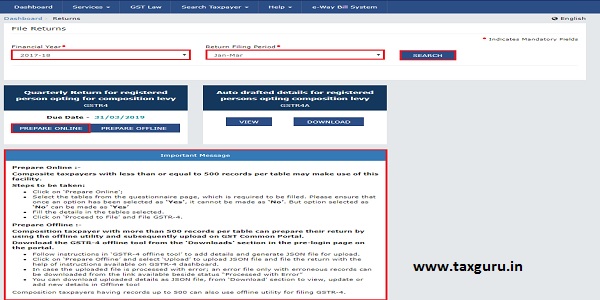
7. A list of questions are displayed. You need to answer all the questions to show the relevant sections applicable to you.
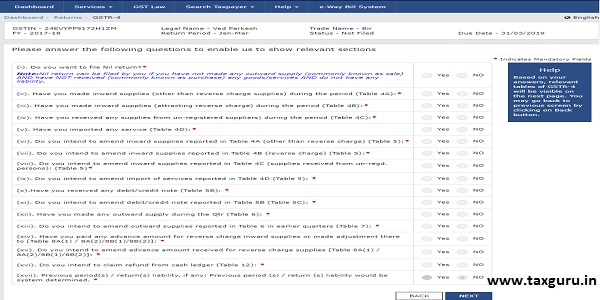
8 (a) To file Nil return: Nil return can be filed by you if you have not made any outward supply (commonly known as sale) and have NOT received (commonly known as purchase) any goods/ services and do not have any tax liability etc.
8.1. Select Yes for option (i).
8.2. Click the NEXT button and follow steps 8.3 to 8.5 below to file Nil Form GSTR-4 for the financial year. .

8.3. Preview Draft GSTR-4
8.4. Proceed to File and Payment of Tax
8.5. File GSTR-4
8 (b) To file Quarterly return:
8.1. Click the NEXT button. Based on your answers, relevant tables of GSTR-4 will only be visible here. You may go back to previous screen by clicking on BACK button.
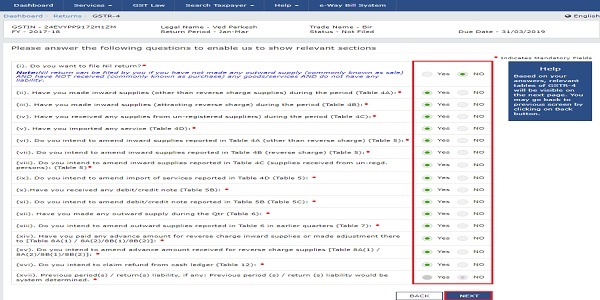
8.2. The GSTR-4 – Quarterly Return page is displayed.
Note:
- Based on the selection made in previous page, applicable tiles will be visible to you for providing the details.
- A question in which Yes, is selected can’t be made ‘No’ after clicking on ‘Next’ button. However, question on which ‘No’ is selected can be made as ‘Yes’ subsequently.
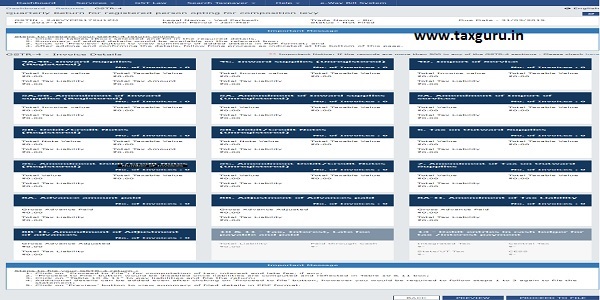
B. Enter details in various tiles
4A, 4B. Inward Supplies (Registered): To add details of inward supplies received from a registered supplier (with or without reverse charge)
4C. Inward supplies (Unregistered): To add details of inward supplies received from an unregistered supplier
4D. Import of Service: To add details of import of service
5A,5B. Amendment of Inward supplies (Registered): To add amendment details of inward supplies received from a registered supplier (with or without reverse charge)
5A. Amendment of Inward supplies (Unregistered): To add amendment details of inward supplies received from an unregistered supplier
5A. Amendment of Import of services: To add amendment details of import of service
5B. Debit/Credit Notes (Registered): To add details of credit or debit notes issued/ received to/from the registered recipients
5B. Debit/Credit Notes (Unregistered): To add details of credit or debit notes issued to the unregistered recipients
6. Tax on Outward Supplies: To add details of tax on outward supplies made (Net of advance and goods returned)
5C. Amendment Debit/Credit Notes (Registered): To add amendment details of credit or debit notes issued/received to/from the registered recipients
5C. Amendment Debit/Credit Notes (Unregistered): To add amendment details of credit or debit notes issued to the unregistered recipients
7. Amendment of Tax on Outward Supplies: To add amendment details of tax on outward supplies made (Net of advance and goods returned)
8A. Advance amount paid: To add details of advance amount paid for reverse charge supplies in the tax
8B. Adjustment of Advances paid: To add details of advance amount on which tax was paid in earlier period but invoice has been received in the current period
8A-II. Amendment of Tax Liability: To add details of amendment of advance amount paid for reverse charge supplies in the tax period
8B-II. Amendment of Adjustment of advances: To add amendment details of advance amount on which tax was paid in earlier period but invoice has been received in the current period
Click on the tile names to know more and enter related details:
4A, 4B. Inward Supplies (Registered)
9.1. To add details of inward supplies received from a registered supplier (with or without reverse charge), click the 4A, 4B. Inward Supplies (Registered) tile.
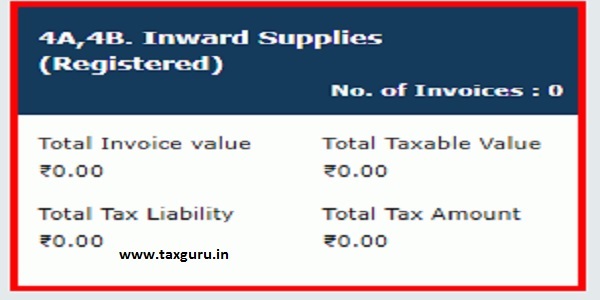
9.2. The B2B Invoices – Supplier-Wise-Summary page is displayed. Click the ADD DETAILS button.

9.3. The B2B – Add Invoice page is displayed.
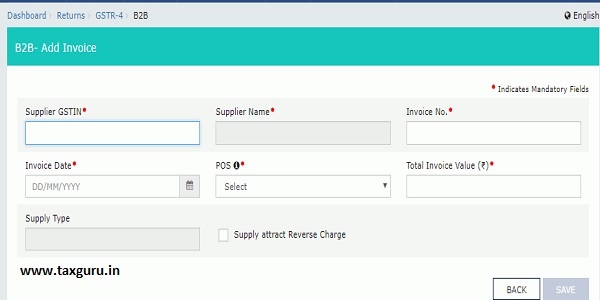
9.4. In the Supplier GSTIN field, enter the GSTIN of the supplier.
9.5. In the Invoice No., Invoice Date and Total Invoice Value fields, enter the Invoice number, date of the invoice and value of the total invoice.
Note:
- Once the GSTIN of the supplier is entered, Supplier Name and Supply Type fields are auto-populated based on the GSTIN of the supplier.
- The auto-populated POS is editable. Depending on selected POS, the supply type gets auto-populated.
- The screen will expand downwards and more fields will appear to enter line item details of the invoice.
9.6. Select the checkbox for Supply attract Reverse Charge, if supply attracts any reverse charge.
9.7. (a) In case of Intra-State transaction:
In case the POS (place of supply) of the goods/ services is the same State as that of the supplier, the transaction is an Intra-State transaction.
Notice, fields for Central Tax and State/UT Tax will appear.
a) In the Taxable Value field against the rates, enter the taxable value of the goods or services.
b) In the Cess field, enter the cess amount.
c) Click the SAVE button to save the invoice details.
Note: The Amount of Tax fields are auto-populated based on the values entered in Taxable Value fields respectively. The CESS field is not auto populated and has to be entered by the taxpayer.
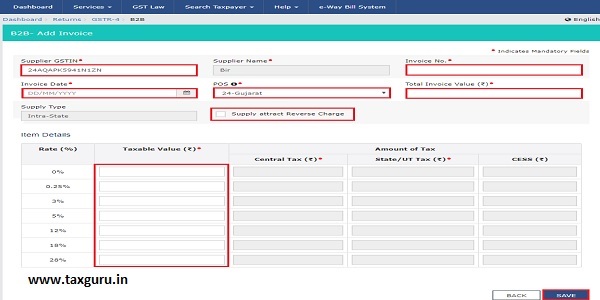
9.7. (b) In case of Inter-State transaction:
In case, the Place of Supply (POS) is different from the State of the supplier, transaction becomes an Inter-State transaction.
Fields for Integrated Tax will appear.
a) In the Taxable Value field against the rates, enter the taxable value of the goods or services.
b) In the Cess field, enter the cess amount.
c) Click the SAVE button to save the invoice details.
Note: The Amount of Tax fields are auto-populated based on the values entered in Taxable Value and tax rate fields respectively. The CESS field is not auto populated and has to be entered by the taxpayer.
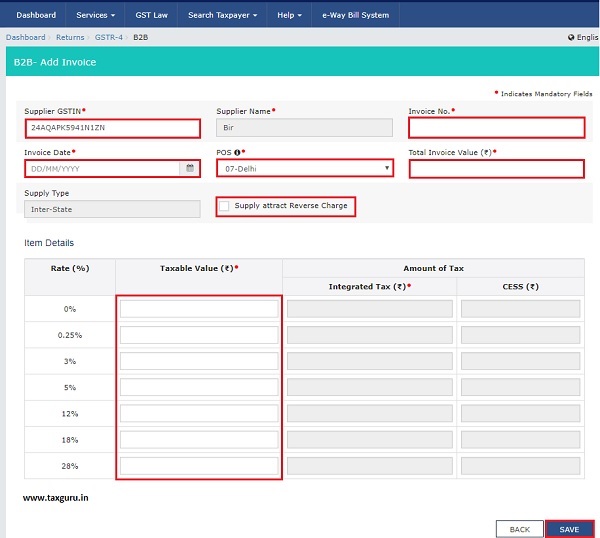
9.8. You will be directed to the previous page and a message is displayed that Request accepted successfully. Here, you can also edit/delete the added invoices (under Actions). Click the BACK button to go back to the GSTR-4 page.
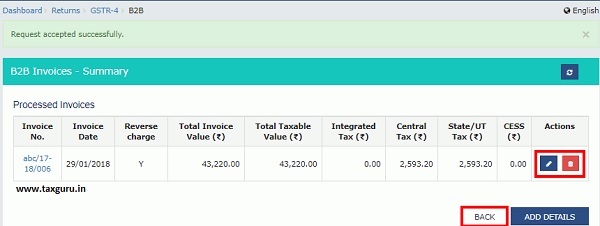
9.9. You will be directed to the GSTR-4 landing page and the 4A, 4B. Inward Supplies (Registered) tile in GSTR-4 will reflect the number of invoices added along with Total Invoice value, Total taxable value, total tax liability and total tax amount entered.
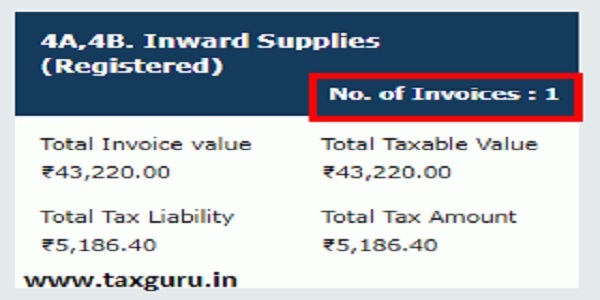
Similarly, you can add more details of inward supplies received from a registered supplier (with or without reverse charge).

Click here to go back to the main menu
4C. Inward supplies (Unregistered)
9.1. To add details of inward supplies received from an unregistered supplier, click the 4C. Inward supplies (Unregistered) tile.

9.2. The 4C. Inward supplies received from an unregistered supplier page is displayed. Click the ADD DETAILS button.

9.3. The B2B Unregistered Supplier – Add Invoice page is displayed.

9.4. In the Invoice No., Invoice Date and Total Invoice Value fields, enter the Invoice number, date of the invoice and value of the total invoice.
9.5. Select the POS from the drop-down list.
9.6. Select the Supply Type from the drop-down list.
9.7. (a) In case of Intra-State transaction:
In case supply type is an Intra-State transaction, fields for Central Tax and State/UT Tax will appear.
a) In the Taxable Value field against the rates, enter the taxable value of the goods or services.
b) In the Cess field, enter the cess amount.
c) Click the SAVE button to save the invoice details.
Note: The Amount of Tax fields are auto-populated based on the values entered in Taxable Value fields respectively. The CESS field is not auto populated and has to be entered by the taxpayer.
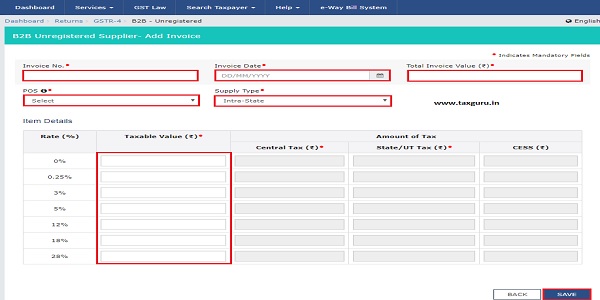
9.7. (b) In case of Inter-State transaction:
In case supply type is an Inter-State transaction, fields for Integrated Tax will appear.
Fields for Integrated Tax will appear.
a) In the Taxable Value field against the rates, enter the taxable value of the goods or services.
b) In the Cess field, enter the cess amount.
c) Click the SAVE button to save the invoice details.
Note: The Amount of Tax fields are auto-populated based on the values entered in Taxable Value and tax rate fields respectively. The CESS field is not auto populated and has to be entered by the taxpayer.
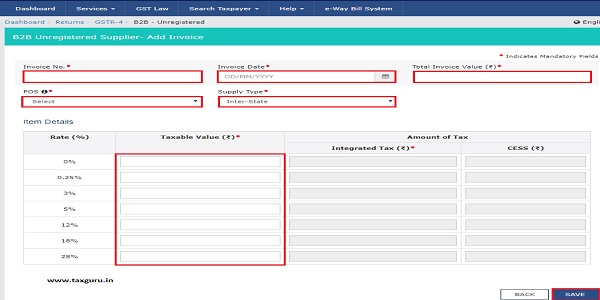
9.8. You will be directed to the previous page and a message is displayed that Request accepted successfully. Here, you can also edit/delete the added invoices (under Actions). Click the BACK button to go back to the GSTR-4 page.
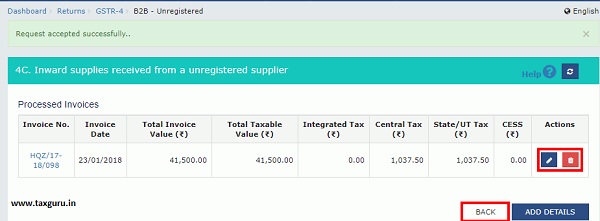
9.9. You will be directed to the GSTR-4 landing page and the 4C. Inward supplies (Unregistered) tile in GSTR-4 will reflect the number of invoices added along with Total Invoice value, Total taxable value and total tax liability.

Similarly, you can add more details of inward supplies received from an unregistered supplier (with or without reverse charge).
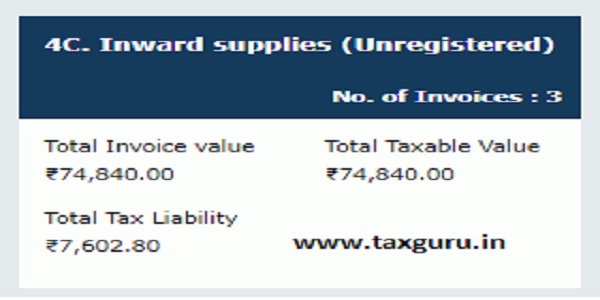
4D. Import of Service
9.1. To add details of import of service, click the 4D. Import of Service tile.

9.2. The 4D. Import of Service page is displayed. Click the ADD DETAILS button.

9.3. The Import of Services – Add page is displayed.
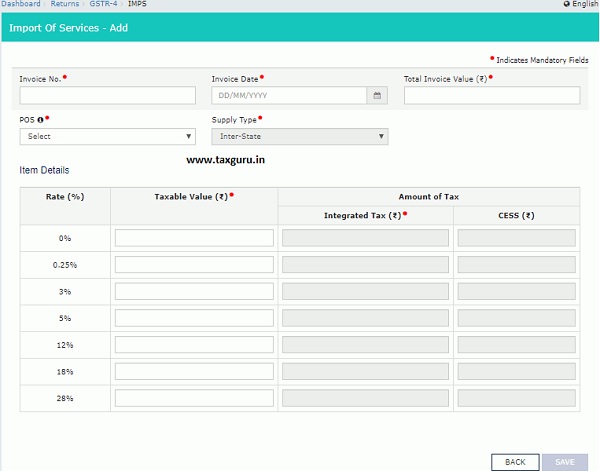
9.4. In the Invoice No., Invoice Date and Total Invoice Value fields, enter the Invoice number, date of the invoice and value of the total invoice.
9.5. Select the POS from the drop-down list.
9.6. In the Taxable Value field against the rates, enter the taxable value of the goods or services.
9.7. In the Cess field, enter the cess amount.
9.8. Click the SAVE button to save the invoice details.
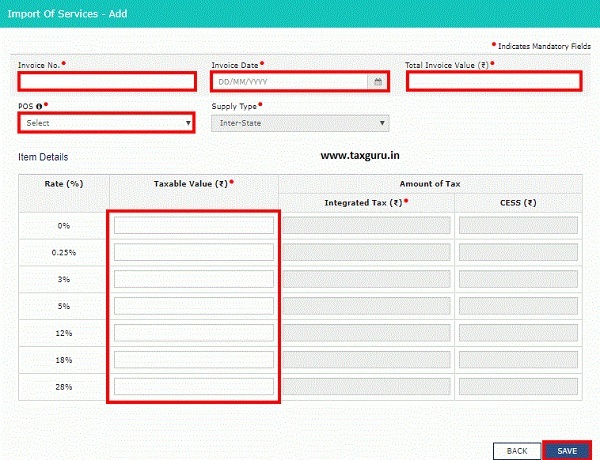
9.9. You will be directed to the previous page and a message is displayed that Request accepted successfully. Here, you can also edit/delete the added invoices (under Actions). Click the BACK button to go back to the GSTR-4 page.
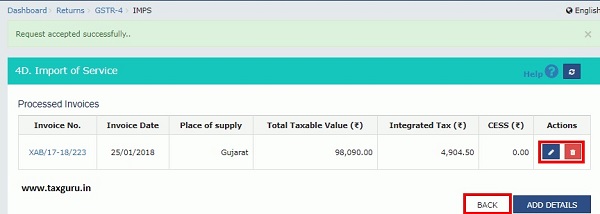
9.10. You will be directed to the GSTR-4 landing page and the 4D. Import of Service tile in GSTR-4 will reflect the number of invoices added along with Total Invoice value, Total taxable value and total tax liability.
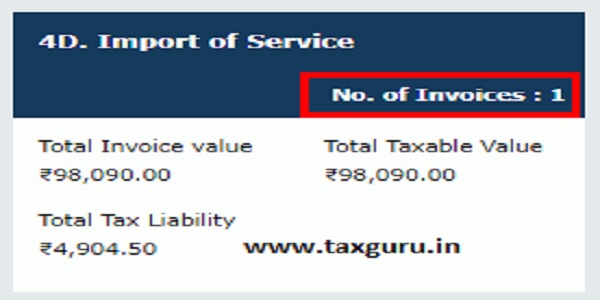
Similarly, you can add more details of import of services.

5A, 5B. Amendment of Inward supplies (Registered)
9.1. To add amendment details of inward supplies received from a registered supplier (with or without reverse charge), click the 5A, 5B. Amendment of Inward supplies (Registered) tile.
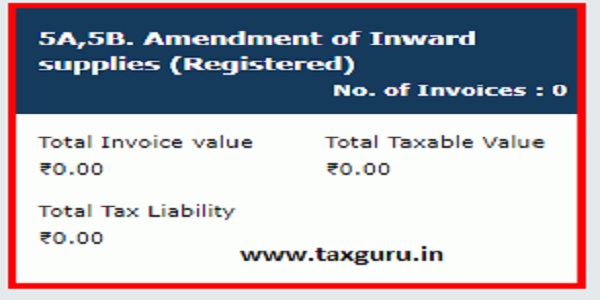
9.2. The Amendment of B2B (Registered) – Summary page is displayed.

9.3. Select the Financial Year from the drop-down list.
9.4. In the Invoice No. field, enter the invoice number which you want to amend from earlier tax period.
9.5. Click the AMEND INVOICE button.

9.6. The Amendment of B2B (Registered) – Summary page is displayed.

9.7. In the Revised Invoice No. field, enter the revised invoice number for the previous invoice.
9.8. Select the Revised Date using the calendar. Make amendments to the details like Revised Invoice No., Revised Invoice Date, Total Invoice Value, Taxable Value etc. as required.
Note: Select the checkbox for Supply attract Reverse Charge, if supply attracts any reverse charge.
9.9. Click the SAVE button.
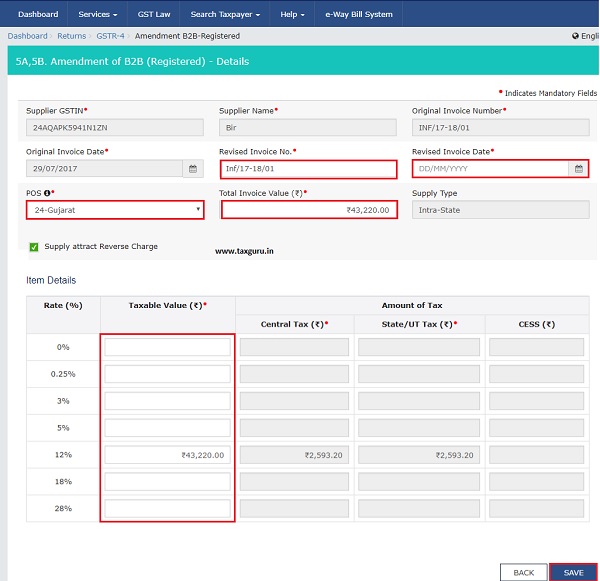
9.10. You will be directed to the previous page. Here, you can also edit/delete the added invoices (under Actions).
9.11. Click the BACK button to go back to the GSTR-4 page.
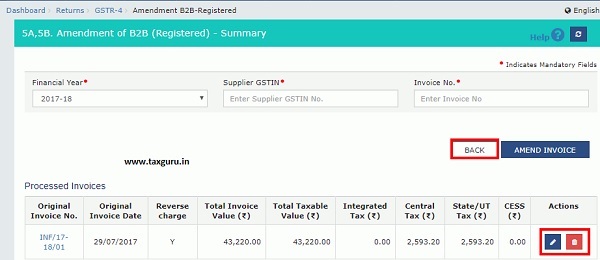
9.12. You will be directed to the GSTR-4 landing page and the 5A, 5B. Amendment of Inward supplies (Registered) tile in GSTR-4 will reflect the number of such invoices amended along with Total Invoice value, Total Taxable Value and Total Tax Liability.
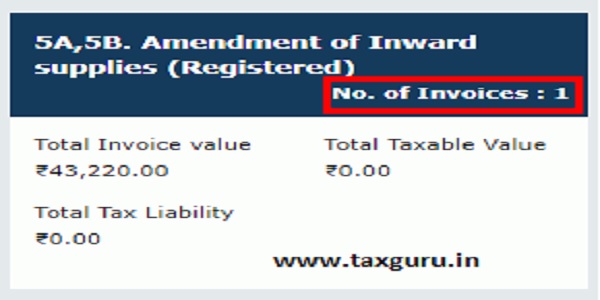
Similarly, you can add amendment details of inward supplies received from a registered supplier (with or without reverse charge).
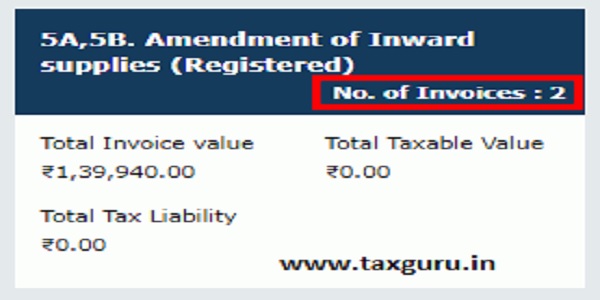
5A. Amendment of Inward supplies (Unregistered)
9.1. To add amendment details of inward supplies received from an unregistered supplier, click the 5A. Amendment of Inward supplies (Unregistered) tile.
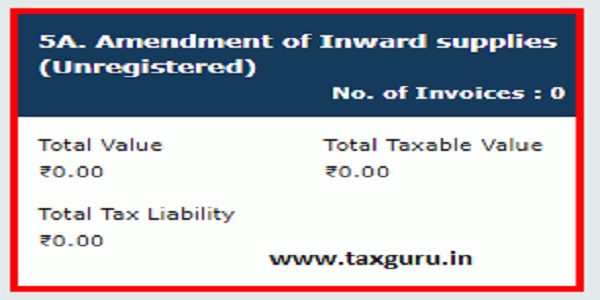
9.2. The Amendment of Inward supplies (Unregistered) page is displayed.

9.3. Select the Financial Year from the drop-down list.
9.4. In the Original Invoice Number field, enter the invoice number which you want to amend from earlier tax period.
9.5. Click the AMEND INVOICE button.

9.6. The Amendment of Inward supplies (Unregistered) page is displayed.

9.7. In the Revised Invoice No. field, enter the revised invoice number for the previous invoice.
9.8. Select the Revised Date using the calendar. Make amendments to the details like Revised Invoice No., Revised Invoice Date, Total Invoice Value, Taxable Value etc. as required.
9.9. Click the SAVE button.
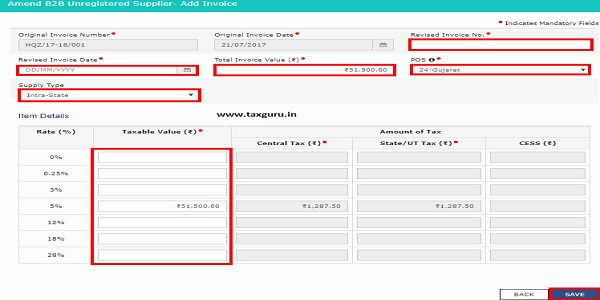
9.10. You will be directed to the previous page. Here, you can also edit/delete the amended invoices (under Actions).
9.11. Click the BACK button.
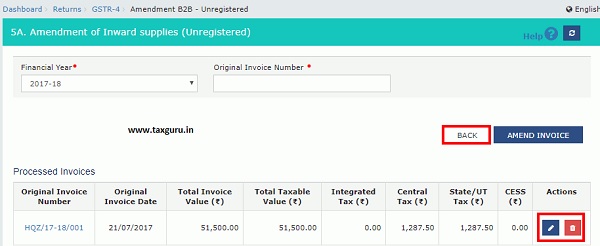
9.12. You will be directed to the GSTR-4 landing page and the 5A. Amendment of Inward supplies (Unregistered) tile in GSTR-4 will reflect the number of such invoices amended along with Total Invoice Value, Total Taxable value and Total Tax Liability.
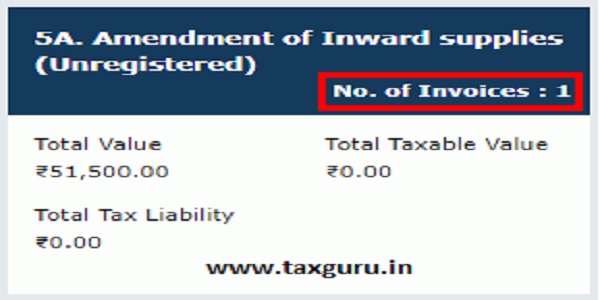
5A. Amendment of Import of services
9.1. To add amendment details of import of services of supplier, click the 5A. Amendment of Import of services tile.
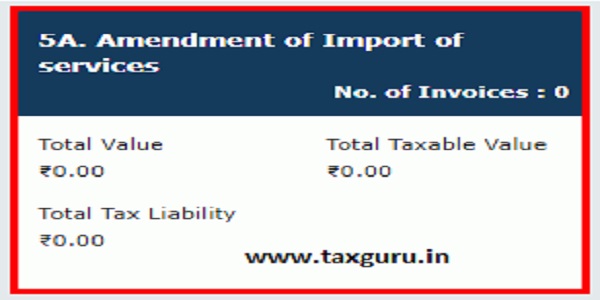
9.2. The Amendment of Import of Services – Summary page is displayed.

9.3. Select the Financial Year from the drop-down list.
9.4. In the Original Invoice Number field, enter the invoice number which you want to amend from earlier tax period.
9.5. Click the AMEND INVOICE button.

9.6. The Amendment of Import of Services – ADD page is displayed.
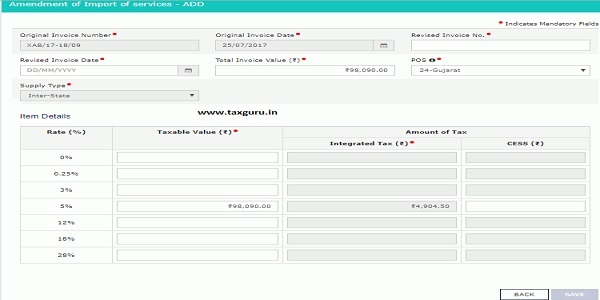
9.7. In the Revised Invoice No. field, enter the revised invoice number for the previous invoice.
9.8. Select the Revised Date using the calendar. Make amendments to the details like Revised Invoice No., Revised Invoice Date, Total Invoice Value, Taxable Value etc. as required.
9.9. Click the SAVE button.
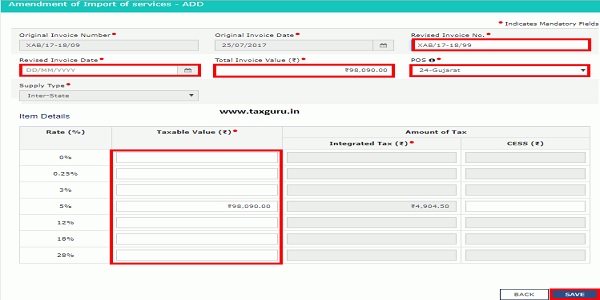
9.10. You will be directed to the previous page. Here, you can also edit/delete the amended invoices (under Actions).
9.11. Click the BACK button.
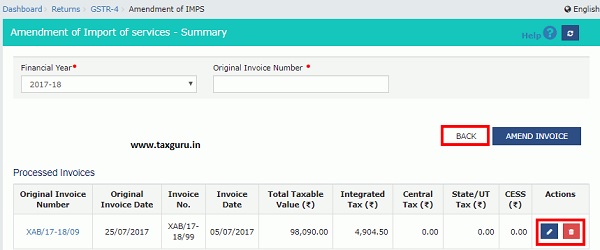
9.12. You will be directed to the GSTR-4 landing page and the 5A. Amendment of Import of services tile in GSTR-4 will reflect the number of such invoices amended along with Total Invoice Value, Total Taxable value and Total Tax Liability.
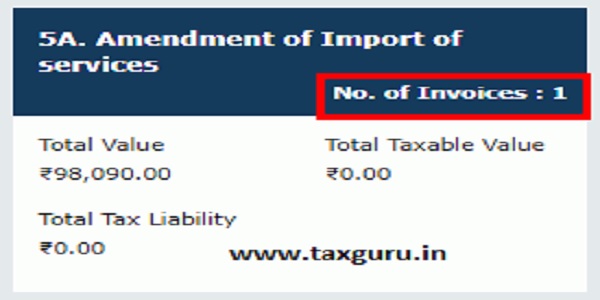
5B. Debit/Credit Notes (Registered)
9.1 To add details of credit or debit notes issued to the registered recipients, click the 5B. Debit/Credit Notes (Registered) tile.

9.2. The Credit/Debit Notes (Registered)- Summary page is displayed. Click the ADD DETAILS button.

9.3. The Credit/Debit Notes (Registered) – Add Note page is displayed.

9.4. In the Supplier GSTIN field, enter the GSTIN of the supplier. Once the GSTIN of the supplier is entered, Supplier Name field is auto-populated based on the GSTIN of the supplier.
9.5. In the Debit/Credit Note No., Debit/Credit Note Date, Note Value and Note Type fields, enter the number, date, value and type of the Debit/Credit Note.
9.6. In the Original Invoice Number and Original Invoice Date, enter the original invoice number and date.
9.7. Select the Supply Type from the drop-down list.
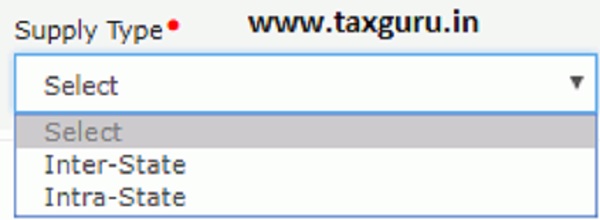
9.8 (a) In case of Intra-State transaction:
In case, the supply type is Intra-State, fields for Central Tax and State/UT Tax will appear.
a) In the Taxable Value field against the rates, enter the taxable value of the goods or services.
b) In the Cess field, enter the cess amount.
c) Click the SAVE button to save the invoice details.
Note: The Amount of Tax fields are auto-populated based on the values entered in Taxable Value and tax rate fields respectively. The CESS field is not auto populated and has to be entered by the taxpayer.

9.8 (b) In case of Inter-State transaction:
In case, the supply type is Inter-State, field for Integrated Tax will appear.
a) In the Taxable Value field against the rates, enter the taxable value of the goods or services.
b) In the Cess field, enter the cess amount.
c) Click the SAVE button to save the invoice details.
Note: The Amount of Tax fields are auto-populated based on the values entered in Taxable Value and tax rate fields respectively. The CESS field is not auto populated and has to be entered by the taxpayer.

9.9. You will be directed to the previous page and a message is displayed that Request accepted successfully. Here, you can also edit/delete the added invoices (under Actions).
9.10. Click the BACK button to go back to the GSTR-4 page.
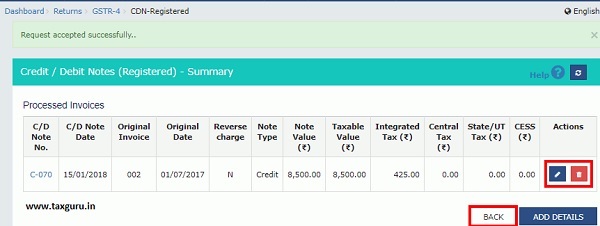
9.11. You will be directed to the GSTR-4 landing page and the 5B. Debit/Credit Notes (Registered) tile in GSTR-4 will reflect the number of invoices added along with Total note value, Total taxable value and total tax liability.
Note: The summary displayed for amendments table can have negative values, in case of downward amendment, as the values displayed are net of (Amended values – Original value).
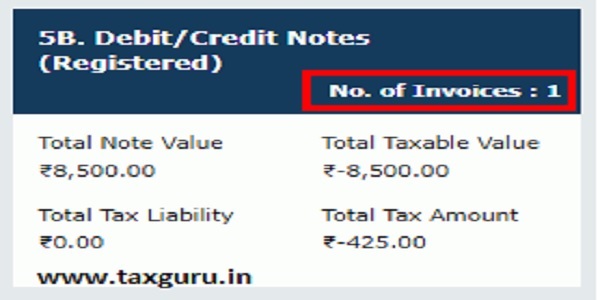
5B. Debit/Credit Notes (Unregistered)
9.1. To add details of credit or debit notes issued to the unregistered recipients, click the 5B. Debit/Credit Notes (Unregistered) tile.

9.2. The Credit/Debit Notes (Unregistered)- Summary page is displayed. Click the ADD DETAILS button.

9.3. The Credit/Debit Notes (Unregistered) – Add Note page is displayed.

9.4. Select the Type from the drop-down list.

9.5. In the Debit/Credit Note No., Debit/Credit Note Date, Note Value and Note Type fields, enter the number, date, value and type of the Debit/Credit Note.
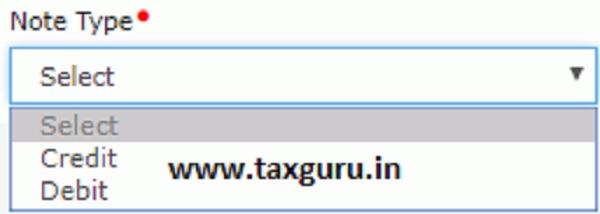
9.6. In the Original Invoice Number and Original Invoice Date, enter the original invoice number and date.
9.7. Select the Supply Type from the drop-down list.

9.8 (a) In case of Intra-State transaction:
In case, the supply type is Intra-State, fields for Central Tax and State/UT Tax will appear.
a) In the Taxable Value field against the rates, enter the taxable value of the goods or services.
b) In the Cess field, enter the cess amount.
c) Click the SAVE button to save the invoice details.
Note: The Amount of Tax fields are auto-populated based on the values entered in Taxable Value and tax rate fields respectively. The CESS field is not auto populated and has to be entered by the taxpayer.
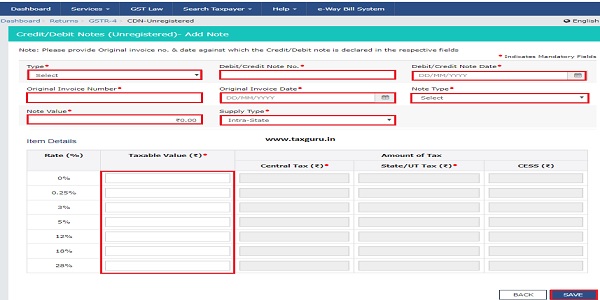
9.8 (b) In case of Inter-State transaction:
In case, the supply type is Inter-State, field for Integrated Tax will appear.
a) In the Taxable Value field against the rates, enter the taxable value of the goods or services.
b) In the Cess field, enter the cess amount.
c) Click the SAVE button to save the invoice details.
Note: The Amount of Tax fields are auto-populated based on the values entered in Taxable Value and tax rate fields respectively. The CESS field is not auto populated and has to be entered by the taxpayer.

9.9. You will be directed to the previous page and a message is displayed that Request accepted successfully. Here, you can also edit/delete the added invoices (under Actions).
9.10. Click the BACK button to go back to the GSTR-4 page.

9.11. You will be directed to the GSTR-4 landing page and the 5B. Debit/Credit Notes (Unregistered) tile in GSTR-4 will reflect the number of invoices added along with Total note value, Total taxable value and total tax liability.

6. Tax on Outward Supplies
9.1. To add details of tax on outward supplies made (Net of advance and goods returned), click the 6. Tax on Outward Supplies tile.
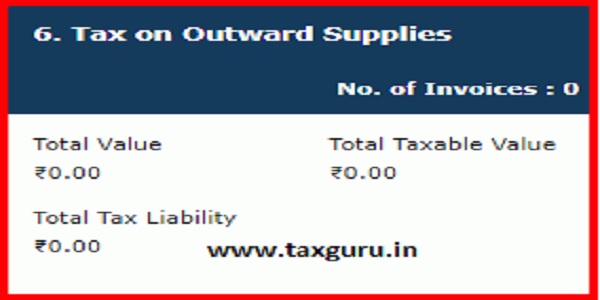
9.2. The Tax on Outward Supplies made (net of advance and goods returned) page is displayed.

9.3. Enter the turnover details against rate of tax for composition tax amount.
9.4. Click the SAVE button.
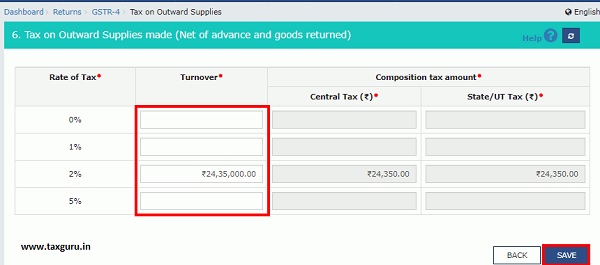
9.5. A message is displayed that Request accepted successfully. Click the BACK button to go back to the GSTR-4 page.
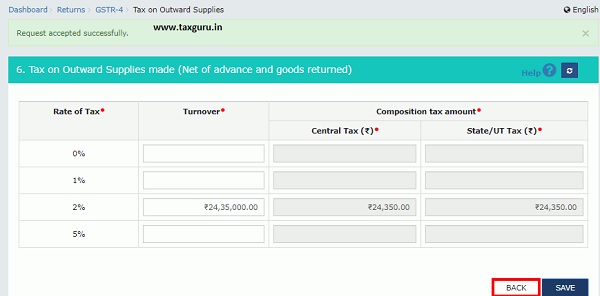
9.6. You will be directed to the GSTR-4 landing page and the 6. Tax on Outward Supplies tile in GSTR-4 will reflect the number of invoices added along with Total value, Total taxable value and total tax liability.
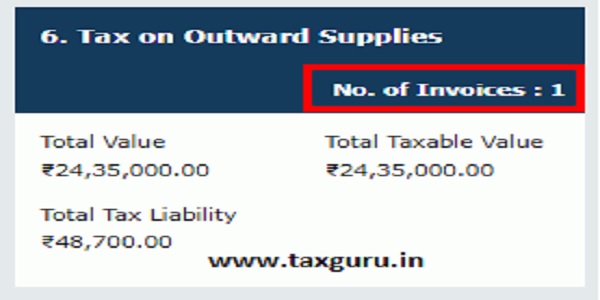
5C. Amendment Debit/Credit Notes (Registered)
9.1. To add amendment details of credit or debit notes issued to the registered recipients, click the 5C. Amendment Debit/Credit Notes (Registered) tile.
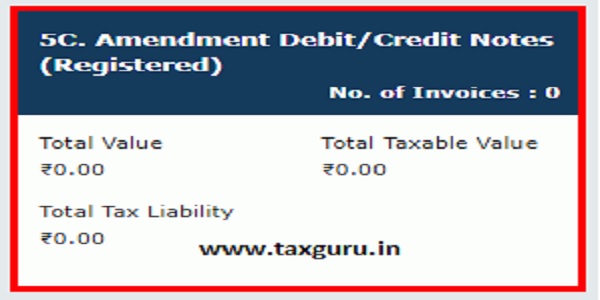
9.2. The Amended Credit/ Debit Notes – Summary page is displayed.

9.3. Select the Financial Year from the drop-down list.
9.4. In the Supplier GSTIN field, enter the GSTIN of the supplier.
9.5. In the Original Note No. field, enter the original note number which you want to amend from earlier tax period.
9.6. Click the AMEND NOTE button.
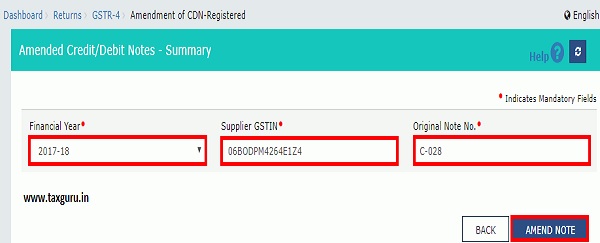
9.7. The Amended Credit/Debit Notes – Add Note page is displayed.
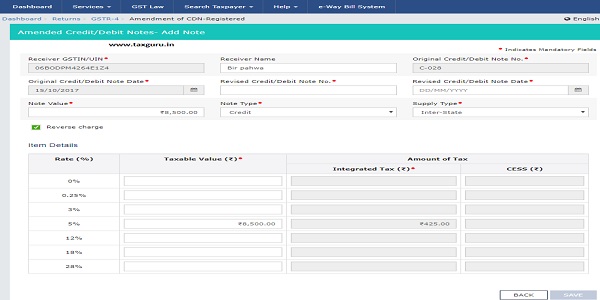
9.8. In the Revised Credit/Debit Note No. field, enter the revised credit or debit note number.
9.9. Select the Revised Credit/Debit Note Date using the calendar. Make amendments to the details as required.
9.10. Click the SAVE button.
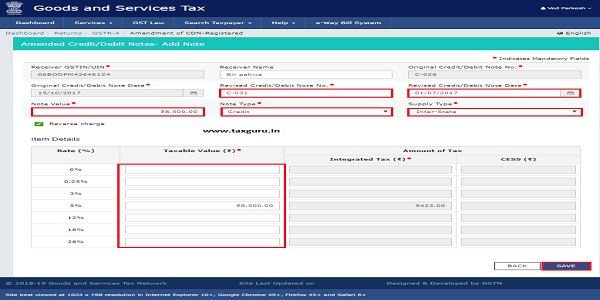
9.11. You will be directed to the previous page. Here, you can also edit/delete the amended invoices (under Actions).
9.12. Click the BACK button.
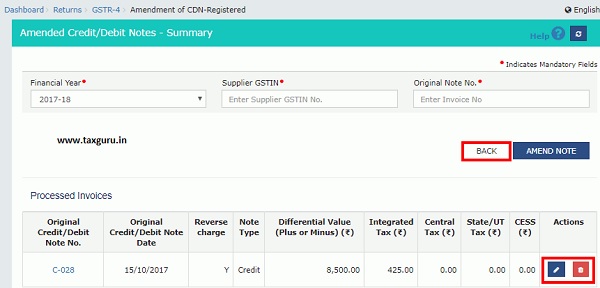
9.13. You will be directed to the GSTR-4 landing page and the 5C. Amendment Debit/Credit Notes (Registered) tile in GSTR-4 will reflect the number of such invoices amended along with Total Invoice Value, Total Taxable value and Total Tax Liability.
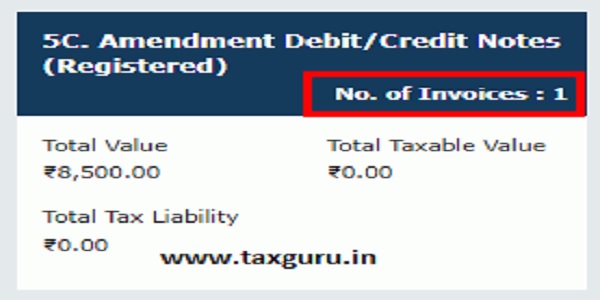
5C. Amendment Debit/Credit Notes (Unregistered)
9.1. To add amendment details of credit or debit notes issued to the unregistered recipients, click the 5C. Amendment Debit/Credit Notes (Unregistered) tile.
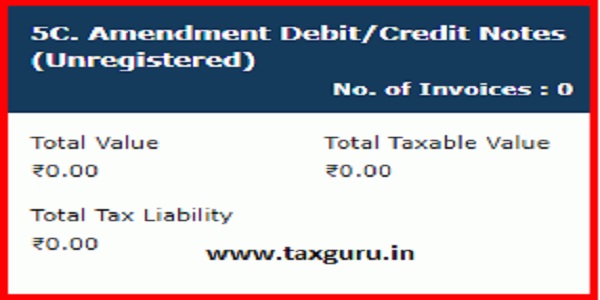
9.2. The Amended Credit/ Debit Notes (Unregistered) – Summary page is displayed.

9.3. Select the Financial Year from the drop-down list.
9.4. In the Original Note No. field, enter the original note number which you want to amend from earlier tax period.
9.5. Click the AMEND NOTE button.

9.6. The Amended Credit/Debit Notes – Details page is displayed.
9.7. In the Revised Credit/Debit Note No. field, enter the revised credit or debit note number.
9.8. Select the Revised Credit/Debit Note Date using the calendar. Make amendments to the details as required.
9.9. Click the SAVE button.
9.10. You will be directed to the previous page. Here, you can also edit/delete the amended invoices (under Actions).
9.11. Click the BACK button.
9.12. You will be directed to the GSTR-4 landing page and the 5C. Amendment Debit/Credit Notes (Unregistered) tile in GSTR-4 will reflect the number of such invoices amended along with Total Invoice Value, Total Taxable value and Total Tax Liability.
7. Amendment of Tax on Outward Supplies
9.1. To add amendment details of tax on outward supplies made (Net of advance and goods returned), click the 7. Amendment of Tax on Outward Supplies tile.
9.2. The Amendment of tax on Outward Supplies page is displayed.
9.3. Select the Financial Year and Return Filing Period from the drop-down list.
9.4. Click the AMEND INVOICE button.
9.5. The Amendment of Tax on Outward Supplies page is displayed.
9.6. Enter the turnover details against rate of tax for composition tax amount.
9.7. Click the SAVE button.
9.8. You will be directed to the previous page. Here, you can also edit/delete the added invoices (under Actions). Click the BACK button to go back to the GSTR-4 page.
9.9. You will be directed to the GSTR-4 landing page and the 7. Amendment of Tax on Outward Supplies tile in GSTR-4 will reflect the number of invoices added along with Total value, Total taxable value and total tax liability.
8A. Advance amount paid
9.1. To add details of advance amount paid for reverse charge supplies in the tax, click the 8A. Advance amount paid tile.
9.2. The Tax Liability (Advance Received)-Summary page is displayed. Click the ADD STATE WISE DETAILS button.
9.3. The Tax Liability (Advance Received) – Add Details page is displayed.
9.4. Select the POS from the drop-down list. Depending on selected POS, the supply type gets auto-populated.
9.5. (a) In case of Intra-State transaction:
Notice, fields for Central Tax and State/UT Tax will appear.
a) In the Gross Advance paidfield against the rates, enter the gross advance paid.
b) In the Cess field, enter the cess amount.
c) Click the SAVEbutton to save the details.
Note: The Amount of Tax fields are auto-populated based on the values entered in Taxable Value fields respectively. The CESS field is not auto populated and has to be entered by the taxpayer.
9.5. (b) In case of Inter-State transaction:
Notice, fields for Integrated Tax will appear.
a) In the Gross Advance paidfield against the rates, enter the gross advance paid.
b) In the Cess field, enter the cess amount.
c) Click the SAVEbutton to save the details.
Note: The Amount of Tax fields are auto-populated based on the values entered in Taxable Value and tax rate fields respectively. The CESS field is not auto populated and has to be entered by the taxpayer.
9.6. You will be directed to the previous page and a message is displayed that Request accepted successfully. Here, you can also edit/delete the added invoices (under Actions). Click the BACK button to go back to the GSTR-4 page.
9.7. You will be directed to the GSTR-4 landing page and the 8A. Advance amount paid tile in GSTR-4 will reflect the number of gross advance paid and total tax liability.
8B. Adjustment of Advances paid
9.1. To add details of advance amount on which tax was paid in earlier period, but invoice has been received in the current period, click the 8B. Adjustment of Advances paid tile.
9.2. The Adjustment of Advances-Summary page is displayed. Click the ADD STATE WISE DETAILS button.
9.3. The Tax already paid on invoices issued in the current period – Add Details page is displayed.
9.4. Select the POS from the drop-down list. Depending on selected POS, the supply type gets auto-populated.
9.5. (a) In case of Intra-State transaction:
Notice, fields for Central Tax and State/UT Tax will appear.
a) In the Gross Advance paidfield against the rates, enter the gross advance paid.
b) In the Cess field, enter the cess amount.
c) Click the SAVEbutton to save the details.
Note: The Amount of Tax fields are auto-populated based on the values entered in Taxable Value fields respectively. The CESS field is not auto populated and has to be entered by the taxpayer.
9.5. (b) In case of Inter-State transaction:
Notice, fields for Integrated Tax will appear.
a) In the Gross Advance paidfield against the rates, enter the gross advance paid.
b) In the Cess field, enter the cess amount.
c) Click the SAVEbutton to save the details.
Note: The Amount of Tax fields are auto-populated based on the values entered in Taxable Value and tax rate fields respectively. The CESS field is not auto populated and has to be entered by the taxpayer.
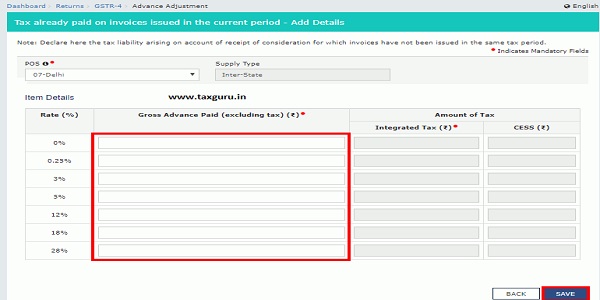
9.6. You will be directed to the previous page and a message is displayed that Request accepted successfully. Here, you can also edit/delete the added invoices (under Actions). Click the BACK button to go back to the GSTR-4 page.
9.7. You will be directed to the GSTR-4 landing page and the 8B. Adjustment of Advances paid tile in GSTR-4 will reflect the number of gross amount adjusted and total tax liability.
8A-II. Amendment of Tax Liability
9.1. To add details of amendment of advance amount paid for reverse charge supplies in the previous tax period, click the 8A-II. Amendment of Tax Liability tile.
9.2. The Amendment Tax Liability (Advance Received) – Summary page is displayed.

9.3. Select the Financial Year and Return Filing Period from the drop-down list.
9.4. Select the POS and Supply Type from the drop-down list.
9.5. Click the AMEND INVOICE button.
9.6. The Tax Liability (Advance Received) – Amend Details page is displayed.
9.7. Amend the Gross Advance Paid details against the rate.
9.8. Click the SAVE button.
9.9. You will be directed to the previous page. Here, you can also edit/delete the added invoices (under Actions).
9.10. Click the BACK button to go back to the GSTR-4 page.
9.11. You will be directed to the GSTR-4 landing page and the 8A-II. Amendment of Tax Liability tile in GSTR-4 will reflect the number of invoices added along with Gross amount adjusted and Total tax liability.
8B-II. Amendment of Adjustment of advances
9.1. To add amendment details of advance amount on which tax was paid in earlier period, but invoice has been received in the current period, click the 8B-II. Amendment of Adjustment of advances tile.
9.2. The Amendment of Adjustment of advances – Summary page is displayed.
9.3. Select the Financial Year and Return Filing Period from the drop-down list.
9.4. Select the POS and Supply Type from the drop-down list.
9.5. Click the AMEND INVOICE button.
9.6. The Amendment of Adjustment of advances – Edit Details page is displayed.
9.7. Enter the Gross Advance Paid details against the rate.
9.8. Click the SAVE button.
9.9. You will be directed to the previous page. Here, you can also edit/delete the added invoices (under Actions).
9.10. Click the BACK button to go back to the GSTR-4 page.
9.11. You will be directed to the GSTR-4 landing page and the 8B-II. Amendment of Adjustment of Advances tile in GSTR-4 will reflect the number of invoices added along with Gross Advance adjusted and Total tax liability.
C. Preview GSTR-4
10. Once you have entered details, click the PREVIEWbutton. This button will download the draft Summary page of your Form GSTR-4 for your review. It is recommended that you download this Summary page and review the summary of entries made in different sections before filing Form GSTR-4.
11. The PDF file is generated with watermark of draft as the details are yet to be submitted.
D. Proceed to File and Payment of Tax
12. Click thePROCEED TO FILEbutton.
13. A message is displayed on top page of the screen that Proceed to file request has been received. Please check the status in sometime. Click the Refreshbutton.
14. Once the status of Form GSTR-4 is “Ready to File”, 10 & 11 – Tax, Interest, Late fee payable and paid tile gets enabled. Click the 10 & 11 – Tax, Interest, Late fee payable and paid tile.
15. The Payment of Tax page is displayed. Go through the instructions as shown at the top of the page.
16.1. The cash ledger balance as available on date is shown in below table.
16.2 (a). Scenario 1: If available balance in Electronic Cash Ledger is less than the amount required to offset the liabilities
i. If available balance in Electronic Cash Ledger is less than the amount required to offset the liabilities, then a part payment of liability can be made from available balance of the Electronic Cash Ledger. Additional cash required to be paid by taxpayer is shown in the “Tax to be paid, Interest to be paid and Late Fee to be paid” column.
You may directly create challan for payment of remaining part of liability, by clicking on the CREATE CHALLAN button.
ii. The Create Challanpage is displayed.
Note: In the Tax Payment grid, the Total Challan Amount field and Total Challan Amount (In Words) fields are auto-populated with amount of remaining part of liability (for which payment is to be made). You cannot edit the amount shown in challan.
iii. Select the Payment Modes as E-Payment/ Over the Counter/ NEFT/RTGS.
iv. Click the GENERATE CHALLANbutton.
v. The Challan is generated.
Note:
In case of Net Banking: You will be directed to the Net Banking page of the selected Bank. The payment amount is shown at the Bank’s website. If you want to change the amount, abort the transaction and create a new challan.
In case of successful payment, you will be re-directed to the GST Portal where the transaction status will be displayed.
In case of Over the Counter:
Take a print out of the Challan and visit the selected Bank. Pay using Cash/ Cheque/ Demand Draft within the Challan’s validity period. Status of the payment will be updated on the GST Portal after confirmation from the Bank.
In case of NEFT/ RTGS:
Take a print out of the Challan and visit the selected Bank. Mandate form will be generated simultaneously. Pay using Cheque through your account with the selected Bank/ Branch. You can also pay using the account debit facility. The transaction will be processed by the Bank and RBI shall confirm the same within <2 hours>. Status of the payment will be updated on the GST Portal after confirmation from the Bank.
Click here to refer the FAQs and User Manual on Making Payment.
16.2 (b). Scenario 2: If available balance in Electronic Cash Ledger is more than/equal to the amount required to offset the liabilities
i. If available balance in Electronic Cash Ledger is more than/equal to the amount required to offset the liabilities, no additional cash payment is required for paying liability.
17. Click the PREVIEW GSTR-4 button to view the summary page of Form GSTR-4 for your review. It is recommended that you download this Summary page and review the summary of entries made in different sections carefully before proceeding further.
18. The summary page of Form GSTR-4 is displayed.
E. File Form GSTR-4 with DSC/ EVC
19. Select the Declarationcheckbox.
20. Select the Authorized Signatoryfrom the drop-down list.
21. Click the FILE GSTR-4button.
22. The Submit Applicationpage is displayed. Click the FILE WITH DSCor FILE WITH EVC button.
23.1. FILE WITH DSC:
a. Select the certificate and click the SIGNbutton.
23.2. FILE WITH EVC:
b. Enter the OTP sent on email and mobile number of the Authorized Signatory registered at the GST Portal and click the VALIDATE OTPbutton.
24. The success message is displayed and ARN is displayed. Status of the Form GSTR-4 return changes to “Filed”. Click the BACK button.
Note: After Form GSTR-4 is filed:
- ARN is generated on successful filing of the Form GSTR-4 Return.
- An SMS and an email are sent to the taxpayer on his registered mobile and email id.
F. View Debit entries in Electronic Cash Ledger for tax payment
25. Click the Debit entries in cash ledger for tax/interest paymenttile.
26. The entries in Electronic Cash Ledger for tax payment is displayed. Click the BACKbutton.
26. Click the PREVIEW button to view the summary in PDF format.
27. The summary is displayed in PDF format.
****
Disclaimer: The contents of this article are for information purposes only and does not constitute an advice or a legal opinion and are personal views of the author. It is based upon relevant law and/or facts available at that point of time and prepared with due accuracy & reliability. Readers are requested to check and refer relevant provisions of statute, latest judicial pronouncements, circulars, clarifications etc before acting on the basis of the above write up. The possibility of other views on the subject matter cannot be ruled out. By the use of the said information, you agree that Author / TaxGuru is not responsible or liable in any manner for the authenticity, accuracy, completeness, errors or any kind of omissions in this piece of information for any action taken thereof. This is not any kind of advertisement or solicitation of work by a professional.


